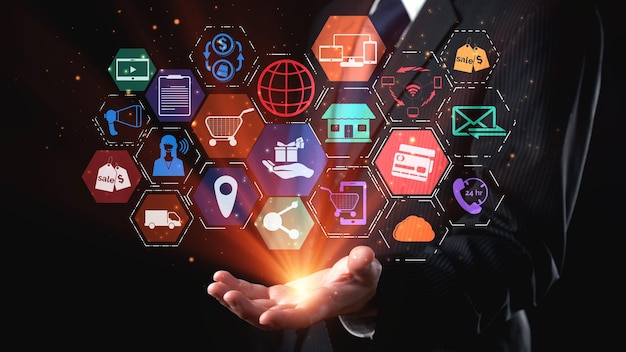7 Steps to build Revenue Enablement

Image Source: FreeImages
Introduction
In today’s rapidly changing business landscape, B2B buyers are reshaping the way they interact with companies, disrupting the traditional buying and selling process. To navigate this complexity and stay ahead of the competition, sales leaders must consider transitioning to a revenue enablement model. Revenue enablement expands the scope of sales enablement to support all revenue-generating functions, prioritize end-to-end revenue metrics, and leverage technology and data to enhance the modern buying and selling experience.
In this comprehensive guide, we will explore the concept of revenue enablement, its advantages over traditional sales enablement, and the key steps involved in designing an effective revenue enablement organization. By the end, you will have a clear understanding of how revenue enablement can transform your business and empower your revenue team to drive strategic growth.
The Changing Landscape of B2B Buying
Evolving B2B buyer preferences and the proliferation of digital touch points have disrupted the buying and selling process. Disjointed messaging and operations across sales, marketing, service, and other customer-facing roles create barriers and hinder growth. The increasing number of touch points also means that different functions are working against different KPIs, leading to chaos and poor performance.
To combat this disruption, sales leaders must adopt a new approach that aligns customer-facing functions and enables seamless interactions throughout the customer journey. This approach is revenue enablement.
Understanding Revenue Enablement
Revenue enablement is a strategic framework that expands the focus of sales enablement beyond the sales organization. It encompasses all revenue-generating channels and customer-facing roles, including inside sales teams, channel managers, presales teams, offer specialists, and customer success teams. It is accelerated by leveraging technology, data, and analytics to enhance enablement efforts and create a consistent and effortless customer experience.
“Revenue enablement connects enablement efforts and uses shared technology, tools, data, analytics, processes, and KPIs to reduce the complexity of the modern sales ecosystem. It provides buyers and sellers with a seamless and more effortless experience.” – Doug Bushee, Senior Director Analyst at Gartner.
Revenue Enablement vs. Sales Enablement
While sales enablement focuses on equipping the sales team with the resources they need to close deals effectively, revenue enablement takes a broader view. It aims to streamline the entire purchase process by providing training, content, and tools to all customer-facing roles involved in the revenue lifecycle. By ensuring that every role has the necessary support, it eliminates friction in handoffs between functions and drives alignment across marketing, sales, and customer success.
Advantages of Revenue Enablement
Transitioning to an enabled revenue model offers several advantages for businesses:
1. Consistency
Revenue enablement fosters consistency by ensuring that all customer-facing roles leverage consistent messaging, technology, and data. This consistency reduces friction in traditional handoffs between functions and creates a seamless experience for buyers and sellers.
2. Alignment
Enablement of all customer-facing teams brings together marketing, sales, and customer success to improve end-to-end revenue generation. Cross-functional collaboration and alignment allow teams to work together towards a shared goal, enhancing the overall customer experience.
3. Visibility
A key benefit is increased visibility throughout the customer buying journey. With a clear view of the customer journey, businesses can optimize their enablement efforts and make data-driven decisions to drive revenue growth.
Designing an Effective Enabled Revenue Organization
To fully leverage the power, businesses need to design a well-structured revenue enablement organization. This organization should encompass role-focused program management and production-focused enablement operations.
Role-Focused Program Management
Role-focused program managers are enablement generalists who tailor enablement programs to the specific needs of various customer-facing roles. These program managers possess domain expertise and are responsible for supporting roles such as SDRs/BDRs, direct sales, presales, indirect sales, and customer success.
Production-Focused Enablement Operations
Enablement operations play a critical role in powering enablement programs at scale. This group consists of digital engagement specialists who optimize content and manage systems to coordinate enablement activities. Additionally, data analysts provide strategic analysis and insights to program managers, enabling data-driven decision-making.
Revenue enablement and agile marketing are interconnected concepts that work together to drive revenue growth and enhance marketing effectiveness. Let’s explore the connection between these two approaches:
Revenue enablement aligns various organizational functions to maximize revenue generation, including sales, marketing, and customer success. It aims to equip these teams with the right resources, tools, and processes to enhance their performance and drive revenue growth. Revenue enablement ensures that teams can access the information, training, and support they need to effectively engage customers and close deals.
Agile Marketing:
Agile marketing is an iterative and flexible approach to marketing that draws inspiration from the agile methodology used in software development. It emphasizes adaptability, collaboration, and continuous improvement. Agile marketing encourages marketers to work in cross-functional teams, prioritize quick iterations and experiments, and respond rapidly to market changes and customer feedback.
Connection between Revenue Enablement and Agile Marketing:
Collaboration and Alignment: Both revenue enablement and agile marketing emphasize collaboration and alignment between sales and marketing teams. Revenue enablement ensures that marketing teams have a clear understanding of sales goals and challenges, while agile marketing promotes closer collaboration between sales and marketing throughout the campaign planning and execution process.
Customer-Centricity: Both approaches prioritize a customer-centric mindset. Revenue enablement focuses on understanding customer needs, preferences, and pain points to equip sales and marketing teams with the knowledge and tools needed to effectively engage customers. Agile marketing emphasizes quick experimentation and adaptation based on customer feedback, allowing marketers to deliver more relevant and targeted messaging and experiences.
Iterative and Data-Driven Approach: Agile marketing encourages marketers to iterate and optimize their campaigns based on data and insights. Similarly, revenue enablement leverages data and analytics to identify gaps and opportunities, enabling continuous improvement in sales and marketing strategies. The two approaches work hand in hand to ensure that marketing efforts are data-driven, allowing teams to make informed decisions and drive revenue growth.
Continuous Learning and Improvement: Both revenue enablement and agile marketing embrace a culture of continuous learning and improvement. Revenue enablement provides training, coaching, and resources to help teams enhance their skills and knowledge, while agile marketing encourages marketers to experiment, learn from the results, and adapt their strategies accordingly. The combination of these approaches supports ongoing growth and optimization in revenue generation efforts.
Adaptability and Agility: Both revenue enablement and agile marketing value adaptability and agility in responding to market changes and customer needs. Revenue enablement equips teams with the tools and resources needed to respond quickly to evolving customer requirements. Agile marketing, with its iterative and flexible approach, allows marketers to pivot and adjust strategies based on changing market dynamics and customer feedback.
By combining revenue enablement and agile marketing, organizations can create a cohesive and dynamic revenue generation approach. The collaboration, customer-centricity, iterative mindset, data-driven decision-making, and continuous improvement fostered by these approaches contribute to enhanced marketing effectiveness, improved sales performance, and ultimately, increased revenue growth.
7 Steps to Revenue Enablement
Revenue enablement is a strategic approach that aligns marketing, sales, and customer success teams to optimize revenue generation and customer retention. Here are seven steps to build revenue enablement within your organization:
- Define Clear Objectives: Start by setting clear and measurable revenue-related objectives. Understand your revenue targets, customer acquisition goals, and customer retention benchmarks. Establish specific key performance indicators (KPIs) to track and measure the success of revenue enablement initiatives.
- Align Sales and Marketing Teams: Foster collaboration and alignment between sales and marketing teams. Encourage regular communication and joint planning sessions to ensure that both teams are on the same page regarding target customers, messaging, and lead handoff processes.
- Create Buyer-Centric Content: Develop content that resonates with your target customers at each stage of their journey. Focus on addressing their pain points, answering their questions, and showcasing the value of your products or services. This will help both marketing and sales teams deliver consistent messaging and increase customer engagement.
- Implement Sales Enablement Tools: Invest in sales enablement technology and tools that empower your sales team with the resources they need to be successful. These tools may include CRM systems, content management platforms, sales training software, and sales automation tools.
- Provide Ongoing Training: Continuously train your sales and customer success teams to stay up-to-date with industry trends, product updates, and effective selling techniques. Offer coaching and skill development sessions to enhance their capabilities in handling customer interactions and objections.
- Enable Customer Success: Revenue enablement doesn’t end with the sales process. Focus on customer success by ensuring that your customer success team has the resources and training they need to support and retain customers. Happy, satisfied customers are more likely to become advocates and refer new business.
- Measure and Optimize: Regularly measure the performance of your revenue enablement efforts. Analyze the data to identify areas of improvement, optimize your processes, and refine your strategies. Use customer feedback and sales data to continually iterate and enhance your revenue enablement initiatives.
By implementing these seven steps, you can build a robust revenue enablement strategy that aligns your teams, enhances customer experiences, and maximizes revenue generation throughout the customer lifecycle. Remember that revenue enablement is an ongoing process, and adapting to changing market conditions and customer needs is crucial for sustained success.
The Future of Revenue Enablement
As the business landscape continues to evolve, revenue enablement will play an increasingly pivotal role in driving strategic growth. It goes beyond traditional sales enablement to empower the entire revenue team to deliver exceptional customer experiences. By embracing this approach and aligning all customer-facing functions, businesses can unlock their full revenue potential and stay ahead in today’s competitive market.
Conclusion
In the age of disruptive B2B buying behavior, businesses must adapt and embrace revenue enablement to thrive. By expanding the focus beyond sales and aligning all revenue-generating functions, companies can create a consistent, aligned, and customer-centric buying experience. It provides the framework necessary to empower the revenue team, optimize enablement efforts, and drive strategic growth. Embrace revenue enablement, and unlock the full potential of your revenue team today.
Editorial Process:
My reviews are written with great care and come from real-world experience. Read my editorial process here.
Some of the links in this article may be affiliate links, which can provide compensation to me at no cost to you if you decide to purchase a paid plan. These are products I’ve personally used/tested and stand behind. This site is not intended to provide financial advice. You can read our affiliate disclosure in our privacy policy.
